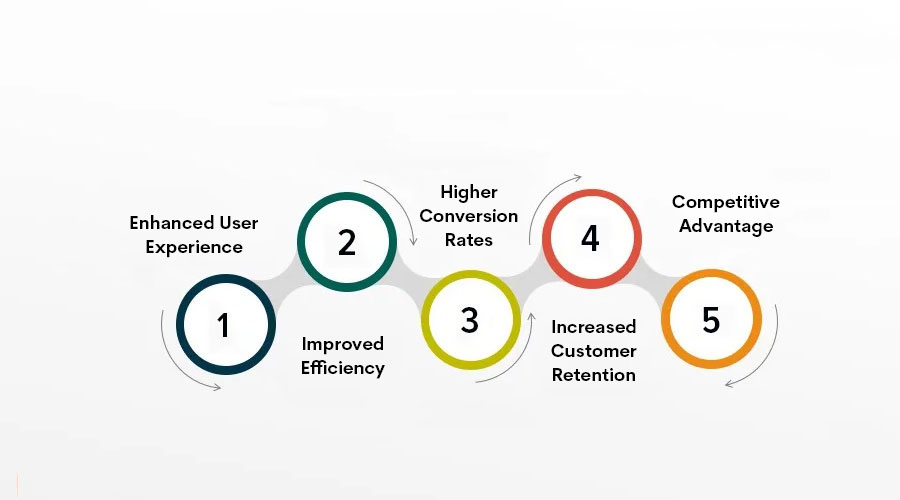Table of Contents
Enhanced User Experience
In the digital landscape, where competition is fierce and attention spans are fleeting, enhancing user experience (UX) has become paramount for businesses striving to stand out. As technology evolves and consumer expectations rise, providing a seamless and gratifying experience to users is no longer optional—it’s a necessity. From websites to mobile apps, every interaction counts, making UX optimization a vital component of any digital strategy.
So, what exactly does “enhanced user experience” entail, and how can businesses achieve it? Let’s delve into some key strategies that can help elevate UX and drive meaningful engagement:
- Understanding User Needs: The foundation of a great user experience lies in understanding the target audience. Conducting thorough research to comprehend user behaviors, preferences, pain points, and goals is essential. This insight serves as a compass, guiding the design and development process to align with user expectations effectively.
- Intuitive Navigation: Users should be able to navigate through a website or application effortlessly. Clear and logical navigation menus, intuitive UI elements, and well-defined pathways ensure that users can find what they’re looking for without frustration. Implementing breadcrumbs, search functionality, and logical hierarchies streamlines navigation and enhances overall usability.
- Responsive Design: With the proliferation of smartphones and tablets, ensuring a seamless experience across devices is crucial. Responsive design adapts the layout and content of a website or app dynamically based on the user’s device, screen size, and orientation. This approach eliminates the need for separate mobile versions, providing a consistent experience regardless of the device used.
- Optimized Page Load Speed: In today’s fast-paced world, users expect instant gratification. Slow-loading pages can lead to high bounce rates and diminished user satisfaction. Optimizing website performance by minimizing HTTP requests, optimizing images, leveraging browser caching, and employing content delivery networks (CDNs) can significantly improve page load speed and enhance the overall user experience.
- Personalization: Tailoring the user experience based on individual preferences and behaviors can foster a deeper connection with users. Leveraging data analytics and AI-driven algorithms, businesses can deliver personalized recommendations, content suggestions, and targeted promotions that resonate with each user’s interests and needs.
- Accessibility: Accessibility is not just a legal requirement; it’s a moral imperative. Ensuring that websites and applications are accessible to users with disabilities is essential for inclusivity. Incorporating features such as alt text for images, keyboard navigation, color contrast adjustments, and screen reader compatibility makes digital experiences accessible to all users, regardless of their abilities.
- Continuous Testing and Iteration: The quest for an exceptional user experience is an ongoing journey. Regularly gathering feedback, conducting usability testing, and analyzing user metrics are indispensable for identifying areas of improvement and fine-tuning the user experience iteratively. Embracing a culture of continuous improvement ensures that the user experience remains relevant and optimized over time.
Flexibility in Content Management
In the dynamic landscape of digital content, flexibility in content management stands as a cornerstone for success. From websites to social media platforms, businesses and individuals alike are continually generating and disseminating content across various channels. In this article, we delve into the importance of flexibility in content management and its implications for modern digital strategies.
Understanding Flexibility in Content Management
Flexibility in content management refers to the ability to adapt, modify, and optimize content seamlessly across different platforms and formats. It encompasses a range of elements, including the structure of content, its presentation, and the tools used for management. Essentially, it empowers content creators and managers to tailor their content according to the specific requirements of diverse channels and audience preferences.
The Need for Flexibility
In today’s digital ecosystem, where consumer preferences and technological advancements evolve rapidly, static content management approaches fall short. Here’s why flexibility is crucial:
- Multi-Channel Presence: With the proliferation of digital channels such as websites, social media platforms, mobile apps, and email newsletters, businesses need to maintain a consistent brand presence across all channels. Flexibility allows content to be repurposed and optimized for each platform, ensuring a cohesive brand experience.
- Content Personalization: Personalized content is increasingly becoming the norm, as consumers expect tailored experiences. Flexibility enables content managers to segment their audience and deliver personalized content based on demographics, preferences, and browsing behavior.
- Agility and Adaptability: In a rapidly changing environment, businesses need to respond quickly to market trends, news events, and consumer feedback. Flexible content management systems empower organizations to make instant updates, revisions, and additions to their content, keeping it relevant and timely.
- SEO and Search Visibility: Search engine algorithms favor fresh, relevant content. Flexible content management allows for regular updates and optimization for search engines, improving visibility and driving organic traffic to websites and digital platforms.
Implementing Flexible Content Management
Achieving flexibility in content management requires a strategic approach and the right tools. Here are some key strategies:
- Adopting a Modular Content Structure: Break down content into modular components such as text, images, videos, and metadata, allowing for easy reuse and repurposing across different channels.
- Investing in Agile Content Management Systems (CMS): Choose CMS platforms that offer flexibility and scalability, with features such as content versioning, workflow management, and seamless integration with third-party tools.
- Embracing Automation and AI: Leverage automation tools and AI-driven solutions for content creation, curation, and distribution. These technologies can streamline content management processes and enable real-time personalization at scale.
- Continuous Monitoring and Optimization: Regularly monitor content performance metrics such as engagement, conversion rates, and bounce rates. Use this data to refine content strategies and optimize content for better results.
Scalability for Business Growth
In the dynamic landscape of modern business, scalability stands as a crucial pillar supporting sustainable growth. Whether you’re a startup aiming to disrupt the market or an established enterprise seeking to expand your horizons, understanding and implementing scalable strategies can be the game-changer that propels you towards success.
What is Scalability?
Scalability refers to the ability of a business to handle increased demands, expand operations, and adapt to growth without sacrificing efficiency or incurring disproportionately higher costs. It’s not just about coping with growth but thriving in the face of it. Think of it as laying down a sturdy foundation that can support the weight of a towering skyscraper without buckling under pressure.
Why is Scalability Essential for Business Growth?
- Flexibility in Operations: Scalable businesses possess the agility to pivot swiftly in response to market shifts, emerging trends, or unexpected challenges. They aren’t bound by rigid structures but rather embrace fluidity, allowing them to capitalize on opportunities as they arise.
- Cost-Efficiency: Traditional growth often entails linear increases in costs, which can quickly erode profitability. Scalable businesses, on the other hand, can achieve exponential growth without proportionate spikes in expenses. By optimizing processes, leveraging technology, and streamlining operations, they maintain cost-efficiency even as they scale up.
- Enhanced Customer Experience: Scalability isn’t just about internal operations; it also extends to customer-facing aspects. A scalable business can seamlessly accommodate a growing customer base without compromising the quality of products or services. This ensures that customer satisfaction remains high, fostering loyalty and positive word-of-mouth.
- Competitive Advantage: In today’s hyper-competitive market landscape, the ability to scale quickly and efficiently can set businesses apart from their rivals. Scalable enterprises can capitalize on market opportunities faster, enter new territories more confidently, and outmaneuver competitors who may be weighed down by bureaucratic red tape or outdated processes.
Strategies for Achieving Scalability:
- Invest in Technology: Embrace automation, cloud computing, and other technological advancements to optimize processes and enhance scalability. From customer relationship management (CRM) systems to enterprise resource planning (ERP) solutions, leveraging the right technology can streamline operations and facilitate growth.
- Focus on Scalable Business Models: Choose business models that inherently lend themselves to scalability. Subscription-based services, SaaS (Software as a Service), and platform-based businesses are prime examples. These models allow for exponential growth without significant increases in overheads.
- Build a Scalable Infrastructure: Ensure that your infrastructure – whether physical or digital – is designed to scale. This includes scalable web hosting, modular architecture, and flexible supply chain management systems. Scalability should be a consideration at every stage of infrastructure development.
- Cultivate a Scalable Culture: Foster a culture of innovation, adaptability, and continuous improvement within your organization. Encourage employees to think outside the box, experiment with new ideas, and embrace change. A culture that values scalability as a core principle will naturally drive growth-oriented initiatives.
Interactive Features for Engagement
In today’s digital landscape, capturing and maintaining audience attention is more challenging than ever. With countless distractions vying for their focus, users demand more than static content – they crave interaction. This is where interactive features come into play, serving as potent tools to engage and immerse your audience in your content. From websites to social media platforms, incorporating interactive elements can elevate your brand’s online presence and foster meaningful connections with your audience.
Interactive features encompass a wide array of tools and techniques designed to encourage user participation and engagement. These may include polls, quizzes, surveys, calculators, interactive infographics, live chats, and more. By allowing users to actively participate rather than passively consume content, these features transform the browsing experience into a dynamic and personalized journey.
One of the key advantages of integrating interactive elements into your digital strategy is their ability to increase user engagement. Unlike traditional static content, interactive features invite users to interact directly with your brand, driving up dwell time and encouraging repeat visits. Whether it’s answering quiz questions, exploring interactive maps, or customizing product options, these immersive experiences captivate users’ attention and keep them coming back for more.
Moreover, interactive features offer valuable insights into user preferences and behavior. By tracking interactions such as quiz responses, survey submissions, or poll votes, brands can gather data that sheds light on audience interests, demographics, and buying habits. Armed with this information, businesses can refine their content strategies, tailor offerings to meet customer needs, and deliver personalized experiences that resonate with their target audience.
In addition to boosting engagement and gathering insights, interactive features can also foster a sense of community and encourage social sharing. Features like live chats or user-generated content platforms enable real-time interactions between users, facilitating discussions, sharing experiences, and building connections around common interests. Furthermore, interactive content that is entertaining, informative, or thought-provoking is more likely to be shared across social media channels, extending your brand’s reach and attracting new followers.
When implementing interactive features, it’s essential to prioritize user experience and ensure seamless integration across all digital touchpoints. From mobile-responsive designs to intuitive navigation, every aspect of the interactive experience should be optimized to provide a smooth and enjoyable journey for users. Additionally, regularly updating and refreshing interactive content helps maintain audience interest and encourages return visits.
SEO-Friendly Structure
In the dynamic realm of digital marketing, mastering the art of SEO-friendly structure is paramount to achieving online success. In today’s fiercely competitive landscape, simply having a website isn’t enough; it must be optimized to stand out amidst the plethora of online content. Understanding and implementing an SEO-friendly structure can significantly enhance your website’s visibility, driving organic traffic and ultimately boosting your online presence. So, let’s delve into the essentials of crafting an SEO-friendly structure that ensures your website shines bright in search engine results.
Understanding SEO-Friendly Structure:
1. Strategic Keyword Placement: Keywords are the backbone of any SEO strategy. Conduct thorough keyword research to identify relevant terms and phrases that resonate with your target audience. Integrate these keywords strategically throughout your website’s content, including titles, headings, meta descriptions, and body text. However, avoid keyword stuffing, as it can have adverse effects on your website’s ranking.
2. Clear and Logical Site Architecture: A well-organized site structure not only enhances user experience but also facilitates search engine crawlers in navigating and indexing your content. Design a logical hierarchy with distinct categories, subcategories, and internal linking to ensure seamless navigation. This not only helps users find relevant information effortlessly but also distributes link equity effectively across your site.
3. Optimized URL Structure: Craft concise, descriptive, and SEO-friendly URLs that reflect the content of each page. Avoid lengthy URLs filled with random characters or numbers, as they can appear spammy and deter users from clicking. Incorporate target keywords naturally into your URLs to convey relevance to both users and search engines.
4. Engaging Meta Tags: Meta tags, including meta titles and meta descriptions, play a pivotal role in attracting clicks from search engine results pages (SERPs). Create compelling meta titles that accurately summarize the content of each page while incorporating primary keywords. Similarly, craft persuasive meta descriptions that entice users to click through to your website by highlighting its value proposition and relevance.
5. Mobile-Friendly Design: With the proliferation of mobile devices, optimizing your website for mobile users is non-negotiable. Ensure responsive design principles are applied to guarantee seamless functionality and optimal viewing experience across various screen sizes. Google prioritizes mobile-friendly websites in its search results, making mobile optimization an indispensable aspect of your SEO strategy.
6. High-Quality Content: Content remains king in the realm of SEO. Create original, informative, and engaging content that adds value to your audience. Incorporate relevant keywords naturally within your content while focusing on readability and user engagement. Regularly update your content to keep it fresh and relevant, signaling to search engines that your website is active and authoritative.
7. Fast Loading Speed: Page speed is a critical ranking factor that significantly impacts user experience and bounce rates. Optimize your website’s loading speed by compressing images, minifying CSS and JavaScript files, leveraging browser caching, and utilizing content delivery networks (CDNs). A fast-loading website not only enhances user satisfaction but also signals to search engines that your site provides a seamless browsing experience.
Integration with Third-Party Services
In today’s fast-paced digital landscape, businesses are constantly seeking ways to streamline their operations, improve efficiency, and enhance functionality. One powerful strategy that has emerged to meet these demands is the integration of third-party services into existing systems and processes. By seamlessly incorporating external tools, platforms, and APIs, businesses can unlock a world of possibilities, ranging from enhanced automation to enriched customer experiences. In this article, we’ll explore the significance of integration with third-party services and how it can benefit businesses across various industries.
Understanding Third-Party Service Integration
Integration with third-party services refers to the process of connecting a company’s internal systems or applications with external services provided by other vendors or developers. These services can encompass a wide range of functionalities, including payment processing, customer relationship management (CRM), marketing automation, analytics, and more. By integrating these external services into their own infrastructure, businesses can leverage the specialized features and capabilities offered by third-party providers, without the need to develop them in-house.
Benefits of Integration
1. Improved Efficiency: Integrating third-party services eliminates the need for manual data entry and reduces the risk of errors associated with manual processes. Automation of tasks such as data synchronization, order processing, and customer support can significantly improve operational efficiency, allowing employees to focus on more strategic initiatives.
2. Enhanced Functionality: Third-party services often offer specialized features and functionalities that may not be available in-house. By integrating these services, businesses can extend the capabilities of their existing systems and provide users with a more comprehensive and feature-rich experience. Whether it’s adding payment gateways to an e-commerce platform or incorporating AI-driven chatbots into customer support channels, integration opens up new possibilities for innovation.
3. Scalability and Flexibility: As businesses grow and evolve, their requirements for software and services may change. Third-party integrations offer scalability and flexibility, allowing companies to adapt to changing needs without having to overhaul their entire infrastructure. Whether it’s adding new features, expanding into new markets, or integrating with emerging technologies, businesses can easily scale their operations with the help of integrated third-party services.
4. Cost Savings: Developing and maintaining in-house solutions can be time-consuming and expensive. By leveraging existing third-party services, businesses can reduce development costs, accelerate time-to-market, and lower overall operational expenses. Additionally, many third-party providers offer flexible pricing models, such as pay-as-you-go or subscription-based plans, allowing businesses to scale their usage according to their needs and budget.
Best Practices for Integration
While integration with third-party services offers numerous benefits, it’s essential to approach the process thoughtfully and strategically. Here are some best practices to consider:
- Identify Business Needs: Clearly define your business objectives and identify the specific functionalities or features you require from third-party services.
- Choose Reliable Providers: Research and select reputable third-party providers with a proven track record of reliability, security, and customer support.
- Ensure Compatibility: Ensure compatibility between your existing systems and the APIs or interfaces provided by third-party services. Conduct thorough testing to identify and address any compatibility issues.
- Prioritize Security: Implement robust security measures to protect sensitive data and ensure compliance with data privacy regulations. Choose third-party providers that prioritize security and offer encryption, authentication, and other security features.
- Monitor Performance: Regularly monitor the performance of integrated services to identify any issues or bottlenecks. Implement monitoring tools and analytics to track key performance indicators and user interactions.
Real-time Updates and Information
In today’s fast-paced world, staying informed is more crucial than ever. With the rapid advancements in technology and the ever-changing landscape of global events, having access to real-time updates and information is essential for individuals, businesses, and organizations alike. From breaking news stories to market fluctuations, real-time updates provide invaluable insights that can shape decision-making processes and drive success.
Why Real-Time Updates Matter
- Timely Decision Making: In many situations, time is of the essence. Whether it’s responding to a crisis, seizing a fleeting opportunity, or adapting to sudden changes, having access to real-time updates allows for quicker and more informed decision making. For businesses, this can mean the difference between staying ahead of the competition or falling behind.
- Accurate Insights: Real-time updates provide a current and accurate snapshot of the situation at hand. Whether it’s weather forecasts, stock market data, or social media trends, having access to up-to-the-minute information ensures that decisions are based on the latest facts and figures rather than outdated or incomplete data.
- Enhanced Communication: In an interconnected world, communication is key. Real-time updates enable seamless communication channels, allowing individuals and organizations to share information instantaneously across various platforms. Whether it’s collaborating with remote teams or engaging with customers on social media, real-time updates facilitate efficient communication in real-time.
Applications Across Industries
- News and Media: The news industry thrives on real-time updates, with journalists and media outlets constantly striving to deliver the latest information to their audiences. From live reporting to minute-by-minute updates, real-time journalism keeps the public informed and engaged on breaking stories and developing events.
- Finance and Trading: In the world of finance, milliseconds can make all the difference. Traders rely on real-time updates to monitor market movements, analyze trends, and execute timely trades. With the rise of algorithmic trading and high-frequency trading, access to real-time market data is essential for staying competitive in the fast-paced world of finance.
- Healthcare: In healthcare, real-time updates play a critical role in patient care and decision making. From monitoring vital signs to tracking disease outbreaks, healthcare professionals rely on real-time data to make informed diagnoses and provide timely treatments. With the advent of telemedicine and remote monitoring technologies, real-time updates are revolutionizing the way healthcare is delivered.
Challenges and Considerations
While real-time updates offer numerous benefits, they also come with challenges and considerations. These include:
- Data Accuracy: Ensuring the accuracy and reliability of real-time data can be a challenge, particularly in fast-moving and dynamic environments.
- Data Overload: With the abundance of real-time information available, individuals and organizations may struggle to filter through the noise and focus on what truly matters.
- Privacy and Security: Real-time updates raise concerns about privacy and security, particularly when it comes to sensitive information and personal data.
Targeted Marketing Capabilities
In today’s digitally-driven landscape, the significance of targeted marketing cannot be overstated. As businesses strive to maximize their ROI and connect with their audience on a deeper level, targeted marketing emerges as a pivotal strategy. Leveraging data analytics, consumer insights, and innovative technologies, targeted marketing enables businesses to deliver tailored messages to specific segments of their audience, fostering engagement, loyalty, and ultimately, conversions.
Understanding Targeted Marketing: Targeted marketing involves the strategic identification and segmentation of audience groups based on various factors such as demographics, behaviors, interests, and preferences. By dissecting the consumer base into smaller, more homogeneous segments, businesses can create highly personalized marketing campaigns that resonate with their target audience on a profound level.
The Power of Data Analytics: At the heart of targeted marketing lies data analytics. Through sophisticated data collection tools and techniques, businesses can gather invaluable information about their customers, including their purchasing habits, browsing history, social media interactions, and more. This data serves as the foundation for understanding consumer behavior and preferences, allowing businesses to tailor their marketing efforts accordingly.
Personalization at Scale: One of the most compelling aspects of targeted marketing is its ability to deliver personalized experiences at scale. Thanks to advancements in marketing automation and AI-driven technologies, businesses can automate the process of delivering personalized content, recommendations, and offers to individual consumers, ensuring relevance and timeliness across multiple touchpoints.
Harnessing the Power of AI and Machine Learning: AI and machine learning algorithms play a pivotal role in enhancing targeted marketing capabilities. These technologies can analyze vast amounts of data in real-time, uncovering patterns, trends, and correlations that human marketers might overlook. By leveraging AI-driven insights, businesses can refine their targeting strategies, optimize campaign performance, and drive meaningful engagement with their audience.
Omni-Channel Integration: In today’s omnichannel environment, consumers interact with brands across a multitude of platforms and devices. Targeted marketing enables businesses to seamlessly integrate their messaging and promotions across various channels, including social media, email, mobile apps, websites, and more. This holistic approach ensures consistency and coherence in the brand experience, regardless of the channel or touchpoint.
Compliance and Ethical Considerations: While targeted marketing offers tremendous opportunities, it also raises important ethical and privacy considerations. Businesses must prioritize data security and compliance with regulations such as GDPR and CCPA to safeguard consumer privacy and trust. Transparent communication and consent mechanisms are essential to ensure that consumers are aware of how their data is being used and have the option to opt-out if desired.
The Road Ahead: As technology continues to evolve and consumer expectations evolve, targeted marketing will remain a cornerstone of modern marketing strategies. By embracing data-driven insights, leveraging advanced technologies, and prioritizing ethical considerations, businesses can unlock the full potential of targeted marketing to drive growth, foster customer relationships, and stay ahead in today’s competitive marketplace.
Streamlined E-commerce Functionality
In today’s digital age, where convenience is king and time is of the essence, businesses are continually seeking ways to streamline their operations to cater to the ever-evolving needs of online consumers. One crucial aspect that cannot be overlooked in this pursuit is the functionality of e-commerce platforms. In this article, we delve into the significance of streamlined e-commerce functionality and how it can unlock success for businesses in the online realm.
Understanding Streamlined E-commerce Functionality
Streamlined e-commerce functionality refers to the seamless integration of features and tools within an online shopping platform to enhance user experience, improve efficiency, and drive sales. It encompasses various aspects, including website navigation, product search, checkout process, payment options, and post-purchase support.
The Benefits of Streamlined E-commerce Functionality
- Enhanced User Experience: A well-designed and intuitive e-commerce platform makes it easier for customers to find what they’re looking for, leading to higher satisfaction and increased likelihood of conversion.
- Improved Efficiency: Streamlined functionality eliminates unnecessary steps and reduces friction in the buying process, allowing for quicker transactions and smoother operations.
- Higher Conversion Rates: Simplifying the path to purchase and offering hassle-free navigation can significantly boost conversion rates, translating into increased sales and revenue.
- Increased Customer Retention: When customers have a positive experience with an e-commerce platform, they are more likely to return for future purchases and recommend the site to others, fostering loyalty and driving repeat business.
- Competitive Advantage: In a crowded marketplace, businesses that prioritize streamlined e-commerce functionality gain a competitive edge by standing out as reliable, user-friendly destinations for online shopping.
Key Features of Streamlined E-commerce Platforms
- Intuitive Design: User-friendly interfaces, clear navigation menus, and responsive layouts are essential for guiding visitors through the purchasing journey seamlessly.
- Advanced Search Capabilities: Robust search functionality with filters, sorting options, and predictive suggestions helps users quickly locate products, improving their overall shopping experience.
- Efficient Checkout Process: A simplified checkout process with guest checkout options, saved payment details, and progress indicators minimizes cart abandonment and maximizes conversions.
- Multiple Payment Options: Offering a variety of secure payment methods, including credit/debit cards, digital wallets, and alternative payment solutions, caters to diverse customer preferences and enhances convenience.
- Responsive Customer Support: Prompt and helpful customer service, including live chat support, email assistance, and comprehensive FAQs, ensures that users receive assistance whenever needed, fostering trust and satisfaction.
Implementing Streamlined E-commerce Functionality
To harness the benefits of streamlined e-commerce functionality, businesses must prioritize optimization and continuous improvement of their online platforms. This involves regularly evaluating user feedback, monitoring analytics data, and staying abreast of industry trends to identify areas for enhancement and innovation.
Collaborating with experienced web developers, UX designers, and e-commerce specialists can facilitate the implementation of tailored solutions that align with the unique needs and goals of the business. By investing in the right technology, optimizing processes, and prioritizing the user experience, businesses can unlock the full potential of their e-commerce operations and achieve sustainable growth in today’s competitive marketplace.
Top Dynamic Website Development Companies
In today’s digitally-driven era, having a dynamic website is not just an option but a necessity for businesses aiming to thrive online. A dynamic website not only enhances user engagement but also provides a personalized experience, thereby boosting conversion rates and driving growth. However, finding the right dynamic website development company amidst the plethora of options available can be a daunting task.
-
-
-
Next Big Technology:

Focus Area
- Mobile App Development
- App Designing (UI/UX)
- Software Development
- Web Development
- AR & VR Development
- Big Data & BI
- Cloud Computing Services
- DevOps
- E-commerce Development
Industries Focus
- Art, Entertainment & Music
- Business Services
- Consumer Products
- Designing
- Education
- Financial & Payments
- Gaming
- Government
- Healthcare & Medical
- Hospitality
- Information Technology
- Legal & Compliance
- Manufacturing
- Media
-
-
- Iflexion: Renowned for its proficiency in leveraging cutting-edge technologies, Iflexion specializes in crafting dynamic websites that offer seamless navigation and superior performance. Their team of skilled developers ensures that each website is optimized for speed, security, and scalability.
- Ruckus: A creative powerhouse in the realm of web development, Ruckus excels in designing dynamic websites that captivate audiences and drive results. Their strategic approach, coupled with a keen eye for aesthetics, makes them a preferred choice for businesses seeking to make a lasting impression online.
- DockYard: Known for pushing the boundaries of innovation, DockYard stands out for its ability to create dynamic websites that push the envelope in terms of design and functionality. Their collaborative approach ensures that every project is executed with precision and attention to detail.
- Konstant Infosolutions: Renowned for its comprehensive suite of web development services, Konstant Infosolutions has carved a niche for itself in the dynamic website development landscape. From e-commerce portals to enterprise solutions, they have the expertise to handle projects of any scale and complexity.
- Merixstudio: With a focus on delivering pixel-perfect websites that resonate with target audiences, Merixstudio ranks among the top dynamic website development companies. Their agile methodology and commitment to client satisfaction have earned them rave reviews from businesses across industries.
- Cyber-Duck: A trailblazer in the digital realm, Cyber-Duck specializes in creating dynamic websites that not only look great but also perform seamlessly across devices. Their holistic approach, encompassing design, development, and optimization, ensures that each website meets the highest standards of quality and usability.
- Blue Fountain Media: Renowned for its innovative approach to web design and development, Blue Fountain Media excels in creating dynamic websites that drive engagement and conversions. With a focus on user experience and functionality, they help businesses establish a strong online presence and achieve their goals.
- Unified Infotech: With a proven track record of delivering exceptional web solutions, Unified Infotech ranks among the top dynamic website development companies. Their team of skilled developers and designers collaborate closely with clients to bring their vision to life and create impactful digital experiences.
- Softura: Specializing in custom web development solutions, Softura stands out for its ability to create dynamic websites that are tailored to meet the unique needs of each client. Their commitment to innovation and excellence has earned them recognition as a trusted partner for businesses looking to elevate their online presence.
FAQs On Dynamic Website Development
In the ever-evolving landscape of digital presence, dynamic websites have emerged as indispensable tools for businesses aiming to engage their audience effectively. However, navigating the realm of dynamic website development can be daunting, especially for those new to the concept. To shed light on this topic, let’s delve into some frequently asked questions surrounding dynamic website development:
1. What Exactly Is a Dynamic Website? A dynamic website is a type of site that displays different content to users based on various factors such as their preferences, interactions, and browsing history. Unlike static websites, which deliver the same pre-built content to all visitors, dynamic websites are crafted to adapt and personalize the user experience in real-time.
2. How Are Dynamic Websites Built? Dynamic websites are typically built using programming languages like PHP, Python, or JavaScript, coupled with databases such as MySQL or MongoDB. These technologies enable developers to create interactive elements, dynamic content, and personalized features that respond to user input and behavior.
3. What Are the Benefits of Dynamic Websites?
Dynamic websites offer numerous advantages, including:
- Personalization: Dynamic websites can tailor content to individual users, providing a more relevant and engaging experience.
- Interactivity: They enable interactive features such as forms, polls, and user-generated content, fostering greater engagement.
- Easy Content Management: Content on dynamic websites can be updated and managed efficiently through content management systems (CMS) like WordPress or Drupal.
- SEO Friendliness: Dynamic websites can be optimized for search engines, allowing businesses to improve their online visibility and reach.
4. Are Dynamic Websites More Expensive to Develop? The cost of developing a dynamic website can vary depending on factors such as complexity, functionality, and the expertise of the development team. While dynamic websites may require a higher initial investment compared to static sites, their long-term benefits often outweigh the costs, especially in terms of user engagement and scalability.
5. Can Dynamic Websites Handle High Traffic? Yes, dynamic websites are designed to scale and can handle high volumes of traffic efficiently. By utilizing techniques such as caching, load balancing, and content delivery networks (CDNs), dynamic websites can maintain optimal performance even during spikes in traffic.
6. Are Dynamic Websites Secure? Security is a crucial aspect of dynamic website development. By implementing best practices such as encryption, secure authentication mechanisms, and regular security audits, developers can mitigate potential risks and safeguard sensitive data from unauthorized access or malicious attacks.
7. Can I Update Content Easily on a Dynamic Website? Absolutely! Content management is one of the key advantages of dynamic websites. With a user-friendly CMS interface, website administrators can easily create, edit, and publish content without the need for technical expertise. This flexibility empowers businesses to keep their websites fresh and relevant with minimal effort.
Thanks for reading our post “Why You Need a Dynamic Website?”. Please connect with us to learn more about Bes Dynamic Website?.






















